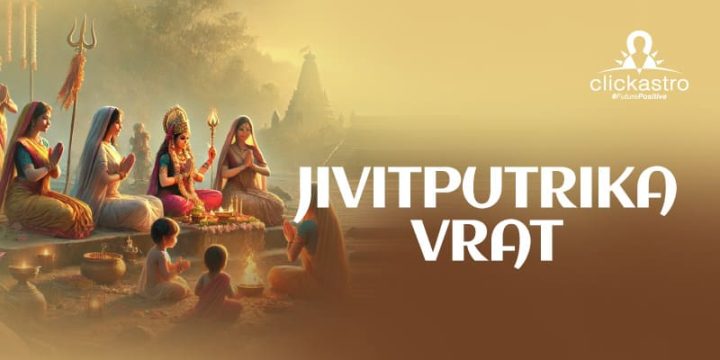Introduction
Jivitputrika Vrat, also known as Jitiya Vrat, is a revered festival that holds deep cultural and religious significance, especially in the northern and eastern states of India, including Bihar, Jharkhand, Uttar Pradesh, and Madhya Pradesh. It is also widely observed in Nepal. This vrat is primarily undertaken by mothers who seek blessings for the long life, prosperity, and well-being of their children. The festival underscores the love, devotion, and sacrifice that mothers are willing to make for the welfare of their offspring.
In 2025, Jivitputrika Vrat will be observed on September 14th, aligning with the Ashtami Tithi (eighth day) of
Krishna Paksha in the Ashwin month of the lunar calendar. The day is marked by rigorous fasting, prayers, and various rituals – traditions that continue to be passed down through generations.
Prayers today, guidance for tomorrow – Get your Horoscope Free!
Historical and Mythological Background
The historical origins of Jivitputrika Vrat are embedded in the ancient legend of King Jimutavahana, a monarch celebrated for his unparalleled compassion, selflessness, and bravery.
King Jimutavahana, although born into royalty and surrounded by the luxuries of a king’s life, found himself disillusioned with worldly pleasures. He was a ruler who prioritised the welfare of his subjects and believed in the greater good. However, his yearning for spiritual fulfilment led him to make a monumental decision—he renounced his throne and the comforts of palace life, handing over the kingdom’s responsibilities to his brothers. With a heart set on spiritual enlightenment, Jimutavahana retreated to the forest, seeking solace and peace in the simplicity of nature.
During his time in the forest,
Jimutavahana came across an elderly woman, inconsolable and weeping in utter despair. This woman belonged to the Nagvanshi clan, a family of serpents, and she revealed to the king the tragic fate that awaited her only son. According to an age-old tradition, her son was destined to be sacrificed to Pakshiraj Garuda, the formidable king of birds, as part of a ritual offering. Every day, a serpent from the Nagvanshi clan was offered to Garuda, and the time had come for her son to be the next victim. Helpless and devastated, the woman feared the loss of her beloved child.

Jimutavahana, moved by the woman’s anguish and guided by his innate sense of justice and compassion, vowed to protect her son. In a selfless act of bravery, he decided to take the place of her son in the sacrificial ritual. Disguising himself in a red cloth, he lay down on the sacrificial rock, offering himself as a meal for Garuda. When Garuda arrived and saw the calm and fearless demeanour of Jimutavahana, he was taken aback. The king showed no fear of death, only a serene acceptance of his fate.
Intrigued by this remarkable display of courage, Garuda questioned Jimutavahana about his true identity. Upon learning of the king’s noble intentions and his willingness to sacrifice his life to save another, Garuda was deeply moved. Impressed by Jimutavahana’s selflessness, Garuda not only spared his life but also vowed to end the practice of sacrificing serpents. This act of compassion and protection of life became the cornerstone of the Jivitputrika Vrat.
Today, Jivitputrika Vrat is observed by mothers who fast and pray for the well-being and longevity of their children, commemorating the selfless sacrifice of King Jimutavahana.
Rituals and Customs of Jivitputrika Vrat
Jivitputrika Vrat is a three-day festival that involves various rituals, each symbolising maternal devotion and the significance of children in one’s life.
1. Nahai-Khai (Day 1):
The first day of the vrat is known as Nahai-Khai, which translates to “bath and eat.” On this day, mothers wake up early, take a holy bath, and then consume a special meal. This meal is considered the last intake before the fast, providing them with the necessary nourishment for the upcoming day of strict fasting. The day also involves preparing for the next day’s rituals by cleaning the house and arranging puja items.
2. Jivitputrika Vrat (Day 2):
The second day is the main day of fasting. Mothers observe a rigorous fast, often refraining from even a drop of water (
Nirjala Vrat). This fast is undertaken with deep devotion and prayer for the well-being of their children. Some women may observe a slightly less strict version of the fast, known as Khur Jitiya, where they are allowed to drink water. The fasting women gather in groups, reciting sacred hymns and singing bhajans (devotional songs). In the evening, they perform puja, offering special food items like wheat, rice, pulses, fruits, and sweets to the deities. The deities primarily worshipped include Lord Vishnu, Lord Shiva, Lord Ganesha, and the Mother Goddess, symbolising the divine protection sought for their children.
3. Paaran (Day 3):
The third day, known as Paaran, marks the end of the fast. After the conclusion of Ashtami Tithi, mothers break their fast by consuming a specially prepared dish. The fasting is often concluded by eating “Kaddu ki Kheer,” a sweet dish made from pumpkin and milk. The rituals of this day signify the end of spiritual and physical endurance and the beginning of joy and celebration.
Regional Variations and Cultural Significance
Jivitputrika Vrat is a revered festival celebrated with distinct regional variations across different parts of India and Nepal, each region adding its unique cultural flavour and traditions to the observance. Despite these differences, the essence of the vrat—mothers fasting and praying for the well-being and longevity of their children—remains consistent.
Bihar and Jharkhand – In the states of Bihar and Jharkhand, Jivitputrika Vrat is celebrated with particular zeal. The festival here is marked by vibrant traditions that are deeply rooted in the region’s cultural heritage. Women in these states often dress in traditional attire, with the colours red and yellow playing a significant role. A sacred thread known as Jitya, typically red and yellow, is tied around their wrists, symbolising protection and good fortune for their children. This thread is believed to ward off evil and ensure the safety of their offspring.
The preparation for the vrat begins with cleaning and decorating the home, where rangolis (intricate patterns made from coloured powders) and flowers are prominently featured. These decorations are considered auspicious and invite positive energies into the home. Women also visit temples to offer special prayers and participate in community rituals, seeking the blessings of the deities for their children’s health, prosperity, and longevity.
Uttar Pradesh – In Uttar Pradesh, Jivitputrika Vrat is observed with similar reverence, but with some unique local customs. The day is dedicated to elaborate pujas where women offer prayers to the Mother Goddess, along with Lord Shiva and Lord Ganesha, invoking their blessings for their children’s well-being. The rituals here often involve detailed offerings, including sacred food items such as wheat, rice, pulses, and fruits, which are presented during the puja.
One of the key rituals in Uttar Pradesh is the breaking of the fast after sighting the moon, which marks the end of the day’s austerities. This moment is often accompanied by community gatherings, where women come together to share their experiences and the significance of the vrat.
Nepal – In Nepal, Jivitputrika Vrat, locally known as Jitiya, is observed with a blend of religious devotion and cultural celebration. The festival is an important occasion for mothers, who come together to perform the prescribed rituals with great dedication. The fasting here is strict, with women abstaining from food and water for the entire day.
Jitiya in Nepal is not just a religious observance but also a cultural event. It is common for women to engage in cultural programs, including singing traditional songs and performing dances that narrate the legends associated with the vrat. These programs serve as a medium to pass down the stories and significance of Jivitputrika Vrat to the younger generation, ensuring that the traditions are preserved and celebrated.
Contemporary Relevance
Jivitputrika Vrat holds deep cultural significance in today’s world. Historically, this vrat has been closely tied to the patriarchal structure of society, where sons were often preferred over daughters due to their role in continuing the family lineage. However, contemporary times have brought about a significant shift in societal values, particularly concerning gender equality. This change is increasingly reflected in the observance of Jivitputrika Vrat.
In recent years, there has been a growing awareness of the need to broaden the scope of this ritual to include daughters. This evolution in practice signifies an important step towards dismantling the age-old preference for male children. Many communities now observe Jivitputrika Vrat for the well-being of all children, irrespective of gender, highlighting the equal importance of daughters in a family. This change challenges the traditional biases that have long favoured sons, promoting a more balanced and inclusive approach to family life.
The expanded observance of Jivitputrika Vrat for both sons and daughters not only reflects a shift in cultural attitudes but also aligns with the broader movement towards gender equality. By recognising the value and importance of all children, this modern adaptation of an ancient ritual serves as a powerful symbol of progress. It underscores the evolving understanding that the well-being of a family is intrinsically linked to the health and happiness of every child, regardless of gender.
Conclusion
Jivitputrika Vrat transcends the boundaries of a festival and embodies the expression of a mother’s unconditional love, sacrifice, and deep devotion to her children. Through the act of rigorous fasting, heartfelt prayers, and meticulously performed rituals, mothers seek divine blessings for the health, prosperity, and longevity of their sons and daughters alike. This sacred observance not only highlights the timeless values of protection and maternal love but also reflects the evolving ethos of modern society. It embraces contemporary values of gender equality and inclusivity, recognising the equal importance of both sons and daughters in the fabric of the family. The festival, therefore, stands as a powerful testament to the enduring strength and resilience of maternal love, adapting to the changing times while preserving the core values that have sustained it for generations.
 Jimutavahana, moved by the woman’s anguish and guided by his innate sense of justice and compassion, vowed to protect her son. In a selfless act of bravery, he decided to take the place of her son in the sacrificial ritual. Disguising himself in a red cloth, he lay down on the sacrificial rock, offering himself as a meal for Garuda. When Garuda arrived and saw the calm and fearless demeanour of Jimutavahana, he was taken aback. The king showed no fear of death, only a serene acceptance of his fate.
Intrigued by this remarkable display of courage, Garuda questioned Jimutavahana about his true identity. Upon learning of the king’s noble intentions and his willingness to sacrifice his life to save another, Garuda was deeply moved. Impressed by Jimutavahana’s selflessness, Garuda not only spared his life but also vowed to end the practice of sacrificing serpents. This act of compassion and protection of life became the cornerstone of the Jivitputrika Vrat.
Today, Jivitputrika Vrat is observed by mothers who fast and pray for the well-being and longevity of their children, commemorating the selfless sacrifice of King Jimutavahana.
Jimutavahana, moved by the woman’s anguish and guided by his innate sense of justice and compassion, vowed to protect her son. In a selfless act of bravery, he decided to take the place of her son in the sacrificial ritual. Disguising himself in a red cloth, he lay down on the sacrificial rock, offering himself as a meal for Garuda. When Garuda arrived and saw the calm and fearless demeanour of Jimutavahana, he was taken aback. The king showed no fear of death, only a serene acceptance of his fate.
Intrigued by this remarkable display of courage, Garuda questioned Jimutavahana about his true identity. Upon learning of the king’s noble intentions and his willingness to sacrifice his life to save another, Garuda was deeply moved. Impressed by Jimutavahana’s selflessness, Garuda not only spared his life but also vowed to end the practice of sacrificing serpents. This act of compassion and protection of life became the cornerstone of the Jivitputrika Vrat.
Today, Jivitputrika Vrat is observed by mothers who fast and pray for the well-being and longevity of their children, commemorating the selfless sacrifice of King Jimutavahana.







